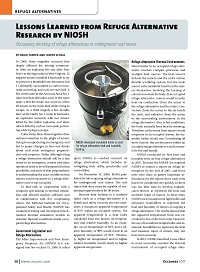Mining Publication: Lessons Learned from Refuge Alternative Research by NIOSH
Original creation date: December 2017
Authors: D Yantek, J Schall
Coal Age 2017 Dec; 122(9):30-34
In 2006, three tragedies occurred that deeply affected the mining community. After an explosion the day after New Year’s at the Sago mine in West Virginia, 12 trapped miners installed a barricade to try to preserve a breathable environment, but 11 ultimately succumbed to carbon monoxide poisoning, and only one survived. A few weeks later at the Aracoma Alma No. 1 mine less than 200 miles away in the same state, a belt fire broke out, and two of the 29 miners in the mine died while trying to escape. In a third tragedy a few months later at the Darby No. 1 mine in Kentucky, an explosion occurred, with two miners killed by the initial explosion and three others killed by carbon monoxide poisoning while trying to escape.
Collectively, these three tragedies drew national attention to the plight of miners trying to escape during an emergency, and led to major changes in how one thinks about coal mine emergency preparedness and response. Today, although using a refuge alternative should still be a last resort in an emergency, miners and mine operators need to be well prepared for that possibility, and part of that preparedness is understanding the exact conditions that miners would encounter in a refuge alternative once it was occupied.
To that end, in cooperation with a company specializing in thermal simulation and infrared analysis software, and in collaboration with five cooperating mines, the National Institute for Occupational Safety and Health (NIOSH) has conducted testing and developed benchmarked thermal simulation models to examine thermal conditions inside occupied refuge alternatives.

Coal Age 2017 Dec; 122(9):30-34
- Emergency Escape and Refuge Alternatives
- How to Operate a Refuge Chamber: A Quick Start Guide
- Recommendations for Refuge Chamber Operations Training
- Refuge Alternatives in Underground Coal Mines
- Technology News 537 - NIOSH Develops New Mine Refuge Chamber Training
- Thermal Stability of ANFO Made with Recycled Oil
- Underground Mine Refuge Chamber Expectations Training: Program Development and Evaluation
- Validation of Temperature and Humidity Thermal Model of 23-person Tent-type Refuge Alternative
- When Do You Take Refuge? Decisionmaking During Mine Emergency Escape
- Work-Principle Model for Predicting Toxic Fumes of Nonideal Explosives